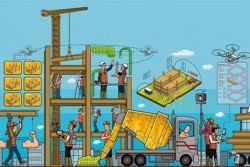While the size of the investment has made headlines, the strategic aim behind the 'National Infrastructure and Construction Pipeline' - the promotion of productivity growth in the construction sector - is no less important. The government aims to bring about enhanced productivity by promoting offsite construction and the adoption of digital and manufacturing techniques. It has committed to leveraging its buying power to support such modernisation and create a stable cross-governmental pipeline of demand.
The message is clear. There is a pipeline of work for those willing to innovate in the property sector.
Projects are already adopting design for manufacture and assembly ("DfMA") to facilitate greater levels of offsite construction. And this is set to become increasingly commonplace. The expansion of Heathrow, for example, will be fuelled by four separate offsite manufacturing facilities.
The government is now consulting on what it calls a "platform" approach to DfMA. This means using digital technology and standardising requirements across its projects so that core parts and components can be used interchangeably on different built assets, wherever possible. The platform approach aims to produce a manufacturing environment similar to the automotive sector, where different designs of car can nevertheless use the same core parts and components.
DfMA (whether platform or not) and offsite manufacture present opportunities for those delivering projects. They have the potential to facilitate improvements in cost, time and quality. However, they require upfront investment, for example, in software, training and facilities capable of delivering the benefits of offsite manufacture.
Enhanced levels of client engagement, from the outset of such projects, will also be crucial to ensuring designs which meet the client's needs can be fixed prior to manufacture. The scope of these designs will also need to be broader, to facilitate transport to, and assembly at, the site. And, of course, risks specific to offsite construction should not be forgotten, for instance the issues of passing of risk and title in manufactured parts, delivery (on a just in time basis), quality control and the interface between the various parts of the project, whether manufactured or traditionally constructed.
Reliance on suppliers to deliver on a just in time basis and enhanced levels of early client engagement will undoubtedly require less adversarial and more collaborative client-contractor and contractor-supply chain relationships.









